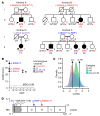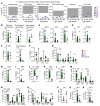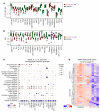IL-7-dependent and -independent lineages of IL-7R-dependent human T cells
- PMID: 39352394
- PMCID: PMC11444196
- DOI: 10.1172/JCI180251
IL-7-dependent and -independent lineages of IL-7R-dependent human T cells
Abstract
Infants with biallelic IL7R loss-of-function variants have severe combined immune deficiency (SCID) characterized by the absence of autologous T lymphocytes, but normal counts of circulating B and NK cells (T-B+NK+ SCID). We report 6 adults (aged 22 to 59 years) from 4 kindreds and 3 ancestries (Colombian, Israeli Arab, Japanese) carrying homozygous IL7 loss-of-function variants resulting in combined immunodeficiency (CID). Deep immunophenotyping revealed relatively normal counts and/or proportions of myeloid, B, NK, and innate lymphoid cells. By contrast, the patients had profound T cell lymphopenia, with low proportions of innate-like adaptive mucosal-associated invariant T and invariant NK T cells. They also had low blood counts of T cell receptor (TCR) excision circles, recent thymic emigrant T cells and naive CD4+ T cells, and low overall TCR repertoire diversity, collectively indicating impaired thymic output. The proportions of effector memory CD4+ and CD8+ T cells were high, indicating IL-7-independent homeostatic T cell proliferation in the periphery. Intriguingly, the proportions of other T cell subsets, including TCRγδ+ T cells and some TCRαβ+ T cell subsets (including Th1, Tfh, and Treg) were little affected. Peripheral CD4+ T cells displayed poor proliferation, but normal cytokine production upon stimulation with mitogens in vitro. Thus, inherited IL-7 deficiency impairs T cell development less severely and in a more subset-specific manner than IL-7R deficiency. These findings suggest that another IL-7R-binding cytokine, possibly thymic stromal lymphopoietin, governs an IL-7-independent pathway of human T cell development.
Keywords: Cytokines; Genetic diseases; Genetics; Immunology; T cell development.
Figures







References
MeSH terms
Substances
Grants and funding
LinkOut - more resources
Full Text Sources
Research Materials

